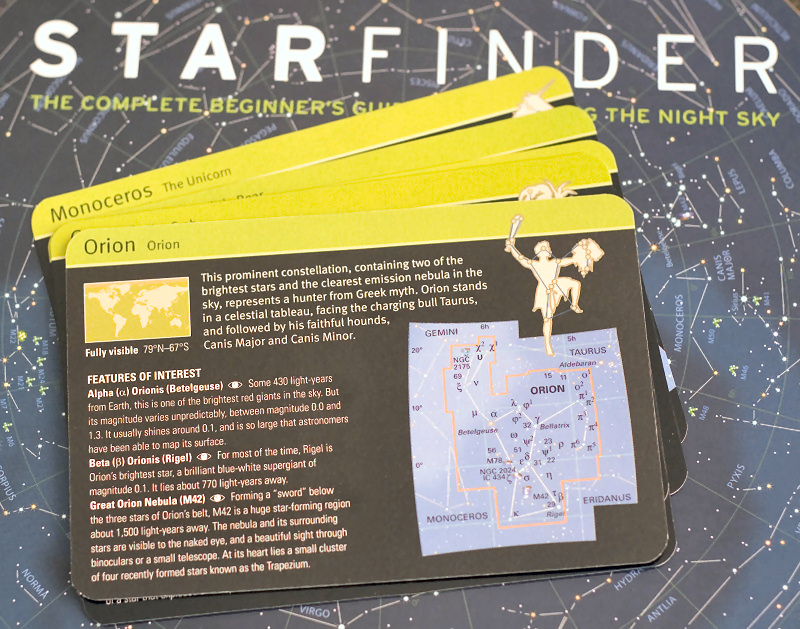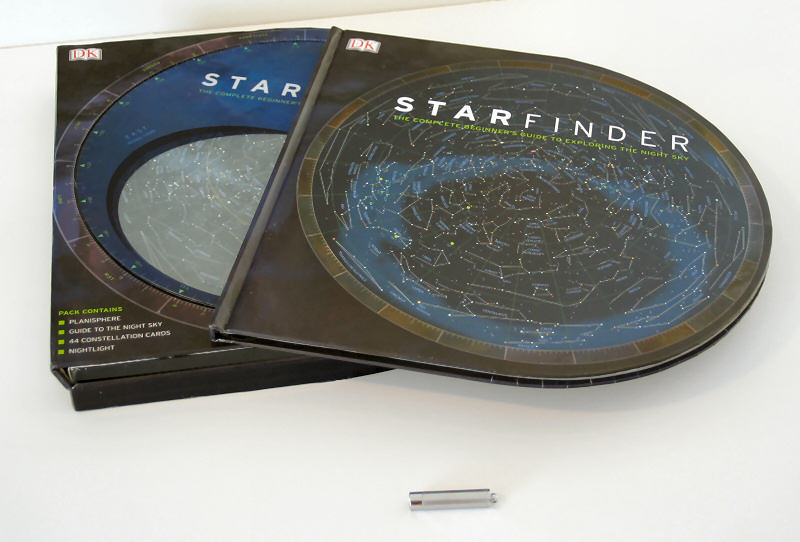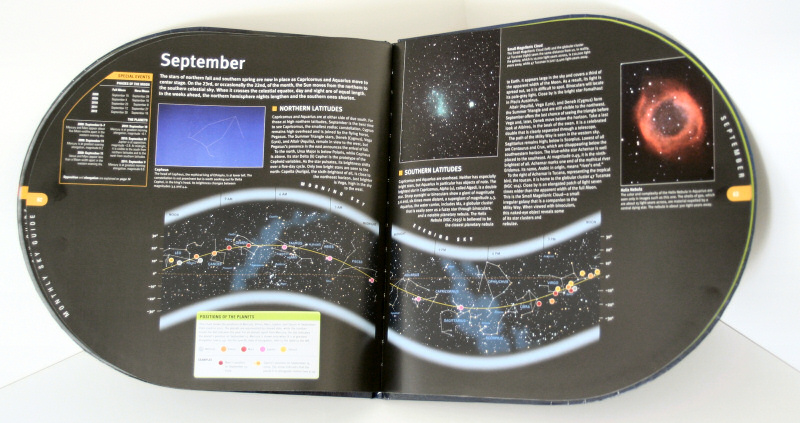 I was recently offered a copy of the book "Starfinder" from DK Publishing to review. I have quite a few Astronomy related books sitting around already, many of which are collecting a bit of dust right now. But it's always interesting to read something new, so I quickly accepted the generous offer. The book arrived and I was immediately surprised by the size. The "book" is actually a multi-functional case for it's contents. It is different & interesting with it's rounded shape, interior compartments, and a planisphere built right into the cover. While the size makes it stand out among other books, it is also slightly inconvenient since I don't have any shelves to accommodate it's 12+" by 12+" dimensions. I prefer the typical 8-1/2x11 size book, although making "Starfinder" any smaller would probably make the planisphere very difficult to read.
I was recently offered a copy of the book "Starfinder" from DK Publishing to review. I have quite a few Astronomy related books sitting around already, many of which are collecting a bit of dust right now. But it's always interesting to read something new, so I quickly accepted the generous offer. The book arrived and I was immediately surprised by the size. The "book" is actually a multi-functional case for it's contents. It is different & interesting with it's rounded shape, interior compartments, and a planisphere built right into the cover. While the size makes it stand out among other books, it is also slightly inconvenient since I don't have any shelves to accommodate it's 12+" by 12+" dimensions. I prefer the typical 8-1/2x11 size book, although making "Starfinder" any smaller would probably make the planisphere very difficult to read.  The cover opens up to reveal some how-to information for using the planisphere, as well as a guide to using the included constellation charts, found in little compartments on the interior of the book. Also inside the book is a small red LED flashlight. I must admit I laughed when first seeing this diminutive device, but it actually performs pretty well under total darkness. Most of us already involved in this hobby will have a good red LED flashlight, but for beginners this one will do just fine.
The cover opens up to reveal some how-to information for using the planisphere, as well as a guide to using the included constellation charts, found in little compartments on the interior of the book. Also inside the book is a small red LED flashlight. I must admit I laughed when first seeing this diminutive device, but it actually performs pretty well under total darkness. Most of us already involved in this hobby will have a good red LED flashlight, but for beginners this one will do just fine. There are 44 double-sided constellation charts included made of sturdy high-quality card stock measuring 5-1/2"x3-3/4" each. They are divided up into 22 northern hemisphere cards and 22 southern hemisphere cards. Each card has a chart of the constellation showing the brighter-magnitude stars and Messier/NGC objects. There's a brief description of interesting objects which indicate if the object is visible by naked eye, binoculars, or telescope.
There are 44 double-sided constellation charts included made of sturdy high-quality card stock measuring 5-1/2"x3-3/4" each. They are divided up into 22 northern hemisphere cards and 22 southern hemisphere cards. Each card has a chart of the constellation showing the brighter-magnitude stars and Messier/NGC objects. There's a brief description of interesting objects which indicate if the object is visible by naked eye, binoculars, or telescope. 
Tucked inside the back is a similarly-shaped reference book which is 72 pages long. This book is divided into three sections: Finding Your Way, The Solar System, and a Monthly Sky Guide. Finding your way has a lot of good information for the beginner explaining the vast distances involved in the universe, how our view of the sky changes with the seasons, basics of constellations, the mechanics of the solar system, objects of our Milky Way and beyond, basic info for getting started viewing, and an overview of "star-hopping." The Solar System section takes you on a tour from the Sun all the way out to Neptune, and even beyond that with comets, asteroids, and dwarf planets.

The final section is a Monthly Sky Guide which takes the reader month-by-month through the sky, describing interesting events & planetary positions over the next five years. A handy chart shows where the planets can be found among the constellations, and if they are in retrograde motion. The Monthly Sky Guide section includes information for both northern and southern hemisphere observers.
Besides the physical size issue I mentioned, my only other minor complaint would be the planisphere. While it is a very nice planisphere, it is built into the front cover and cannot be removed. I would love to be able to take just the planisphere outside without having to hold up the entire bulk of this book. Overall I found the content to be appropriate for the beginner while still being a handy guide for the seasoned observer. This book will give anyone a good start into astronomy without a lot of technical talk. The price is not bad either, just $18.40 from Amazon.com.
1 comment:
That was a really informative post,and for a beginner like me,I may have to get one.Price sounds right and having a good planisphere is handy.Thanks
Post a Comment